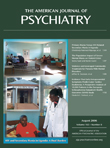Primary Mania Versus HIV-Related Secondary Mania in Uganda
Abstract
Objective: The authors hypothesized that in the majority of HIV-positive patients presenting with mania, the mania is secondary to HIV infection and that its presentation and correlates differ from those of HIV-negative patients with primary mania. Method: A comparative cross-sectional study was conducted with HIV-negative and HIV-positive patients admitted to psychiatric wards with acute mania. The authors compared the patients’ psychiatric, physical, and immunological (CD4 cell counts) and other laboratory parameters. Pairwise comparisons were done for the two groups on a number of variables. Results: Of 141 patients who presented with acute mania during a 6-month period and were eligible for the study, 61 met criteria for HIV-related secondary mania. Compared with HIV-negative patients with primary mania, they were older, more cognitively impaired less educated, and more likely to be female. Patients in this group had more manic symptoms: they were more irritable, more aggressive, more talkative, and had higher rates of paranoid delusions, visual hallucinations, and auditory hallucinations. More of the HIV-positive secondary mania group had CD4 counts below 350 cells/mm 3 . Conclusions: Primary mania and HIV-related secondary mania are clinically and immunologically distinct. The relation between secondary mania and depressed CD4 counts suggests that in the setting of an HIV/AIDS epidemic in poor countries, secondary mania may be used as an indicator to initiate highly active antiretroviral therapy.



